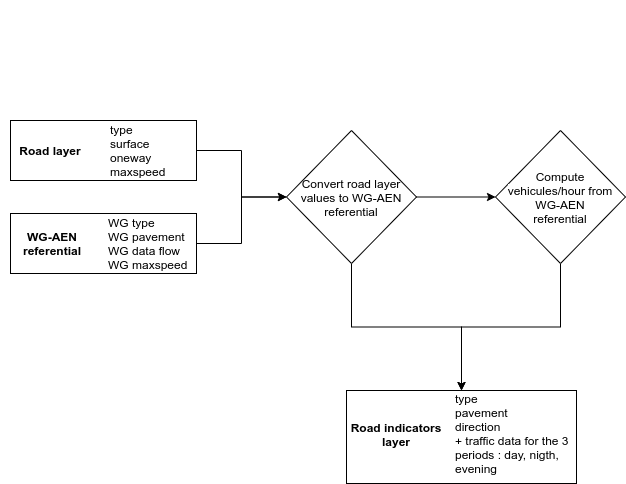-
Notifications
You must be signed in to change notification settings - Fork 16
Road indicators
GeoClimate offers a processing chain to compute road traffic indicators based on the table Tool 2.5 (WG-AEN method) described in Good Practice Guide for Strategic Noise Mapping and the Production of Associated Data on Noise Exposure Version 2 13th January 2006. The chain uses the GeoClimate road layer and a configuration file that contains informations to establish relations between the WG-AEN referential and the road layer features :
- a mapping from WG-AEN road types to the road layer types (WG type)
- the CNOSSOS-EU pavement codes according the surface values available in the road layer (WG pavement)
- the Tool 2.5 flow data by WG-AEN road types for the 3 periods day, night, evening (WG data flow)
- the maximum speed value according the WG-AEN road types (WG maxspeed)

Figure 3. Processing steps to compute a road traffic flow based on WG-AEN referential
For each road geometry, the road layer generic fields "type", "surface", "oneway" and "maxspeed" are wrapped to the WG type, pavement and direction defined in the WG-AEN referential.Those values are then are intersected with the WG data flow to compute the number of light and heavy vehicles per hour for the 3 time periods : day (06:00-18:00), evening (ev) (18:00-22:00) and night (22:00-06:00).
The 16 resulting indicators are stored in the "road_indicators" table:
- the WG-AEN road type,
- the pavement code,
- the direction of the road section. 1 = one way road section and the traffic goes in the same way that the slope definition you have used, 2 = one way road section and the traffic goes in the inverse way that the slope definition you have used, 3 = bi-directional traffic flow, the flow is split into two components and correct half for uphill and half for downhill,
- the number of light vehicles per hour for day,
- the number of heavy vehicles per hour for day,
- the light vehicles speed for day,
- the heavy vehicles speed for day,
- the number of light vehicles per hour for night,
- the number of heavy vehicles per hour for night,
- the light vehicles speed for night,
- the heavy vehicles speed for night,
- the number of light vehicles per hour for evening,
- the number of heavy vehicles per hour for evening,
- the light vehicles speed for evening,
- the number of heavy vehicles per hour for evening,
- the slope (in %) of the road section
GeoClimate - documentation 2020 - 2024 -
This work is licensed under a Creative Commons Attribution-ShareAlike 4.0 International.
